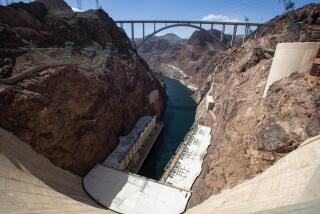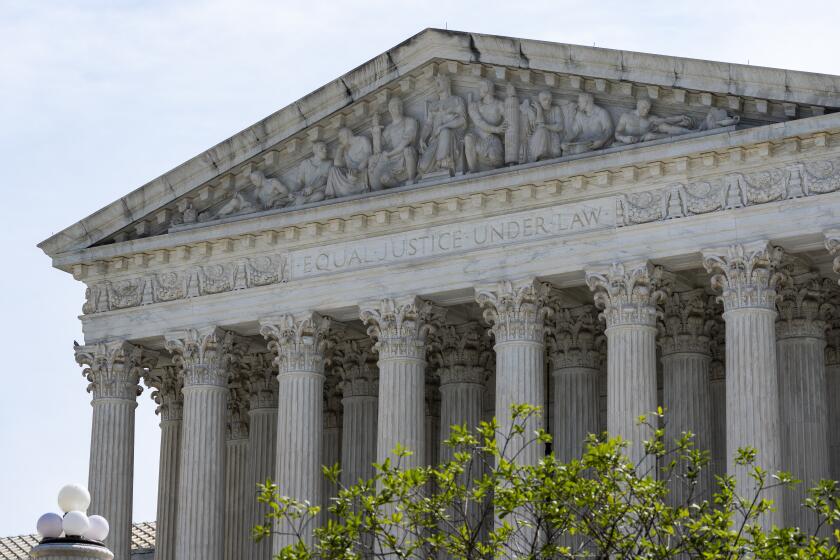Vote Set on Water Rationing Proposal : Conservation: The MWD plan calls for cutbacks ranging from 5% for residential consumption to 20% for agriculture.
- Share via
Directors of the Metropolitan Water District of Southern California are scheduled to vote today on staff and committee recommendations to impose the first mandatory water rationing here since the drought of 1976-1977.
If approved, the staff-proposed cutbacks, ranging from 5% for overall residential consumption to 20% for agricultural use, probably would be imposed beginning in February. How the mandatory rationing would affect individual customers has yet to be determined.
The MWD staff says that the current four-year statewide drought--coupled with uncertain forecasts about rain this winter, increased usage of Colorado River water by Arizona, and environmental rulings that reduce the amount of water available here from the Owens Valley--have made voluntary conservation efforts inadequate.
After reviewing reports of dwindling reservoir supplies and pessimistic weather forecasts, the Water Problems Committee of the MWD board voted Monday to recommend approval of the staff’s proposals by the full board at its regular meeting this afternoon. Sources close to the issue said the board probably will go along with the staff and committee recommendations.
Tim Skrove, a spokesman for the agency, said there is a growing sense of urgency.
“The rainfall so far this year has been pitiful,” he said, adding that the light showers considered possible tonight, Wednesday and Thursday “aren’t going to make a hill of beans’ difference.”
“The weather factor is very dismal,” he said.
The MWD collects water from the Colorado River and the State Water Project in Northern California and sells it to cities and other water distribution agencies throughout Southern California.
Under the proposal to be considered by the MWD board, district deliveries of water for “uninterruptible” residential and industrial use would be cut by 5% and deliveries for “interruptible” agricultural use and ground-water replenishment would be cut by 20%
Under the plan, the price of water delivered to a city or agency would triple if the reduction quota is not met.
How these cutbacks--and penalties--would be passed along to consumers is uncertain, officials said.
In Los Angeles, water from the MWD is distributed by the city’s Department of Water and Power.
Last month, the DWP announced that voluntary water conservation efforts were falling far short of the 10% cutbacks needed to head off mandatory rationing in the city.
Nonetheless, Mayor Tom Bradley, who had begun pushing for mandatory water rationing as far back as last spring, said he would hold off asking the City Council to impose a mandatory program.
“Basically, the decision on what we do is up to the council,” said Ed Freudenberg, a spokesman for the municipal utility. “The ball is in their court.”
Skrove said several factors have combined to make the situation urgent in Southern California.
First and foremost is the continuing drought. While precipitation has been unusually heavy in the Pacific Northwest this fall, little of it has drifted far enough south to begin replenishing the mid-state Sierra snowpack. Still less has fallen in the Southland, where ground-water supplies are getting dangerously low in some areas.
Although it is located toward the northern half of the state, the Sierra snowpack usually is a primary source of water for Southern California and Los Angeles.
Melting snow from the western flank of the mountain range provides water for much of the southern part of the state through the California Aqueduct. Runoff from the eastern flank, collected in Mono and Inyo counties and delivered here through the Owens Valley Aqueduct, usually provides 80% of Los Angeles’ needs.
This year, because of the drought and because of environmental rulings, the flow of the Owens Valley Aqueduct is minimal, and the city is largely dependent on its meager ground-water supplies and what it can get from the MWD.
The MWD gets most of its water from the Colorado River. Until recently, Arizona was unable to use its full, court-mandated share of the river water because of limited distribution systems and Southern California received most of what was available. Now, Arizona has largely completed its Central Arizona Project, and the amount left for California is shrinking.
The mandatory cuts to be considered today represent the second of a five-phase “incremental interruption and conservation plan” developed by the MWD staff.
The first phase, put into action by the agency without fanfare on Dec. 1, was designed to achieve voluntary cutbacks of 10% in the residential-industrial categories and unspecified amounts in the agricultural and ground-water categories.
If the drought continues and Phase II of mandatory cuts of 5% and 20% proves inadequate, Phase III would mandate cutbacks of 10% and 30%. With worsening conditions, the cuts would rise to 15% and 40% in Phase IV and 20% and 50% in Phase V.
More to Read
Sign up for Essential California
The most important California stories and recommendations in your inbox every morning.
You may occasionally receive promotional content from the Los Angeles Times.













